
Little bits of NAMM... Part 2
NAMM Countdown - Day -1
The first NAMM event I attended was a pre-show event on the Wednesday evening organised by the insanely upbeat Lewis Richard from 17th St Studios, a South LA studio jam packed with character and cool instruments and outboard gear littered throughout the various rooms and halls that make up the facility. I left LAX in my hire car and immediately turned into Glasgow Place so I knew I was on the right road and headed for the studio.
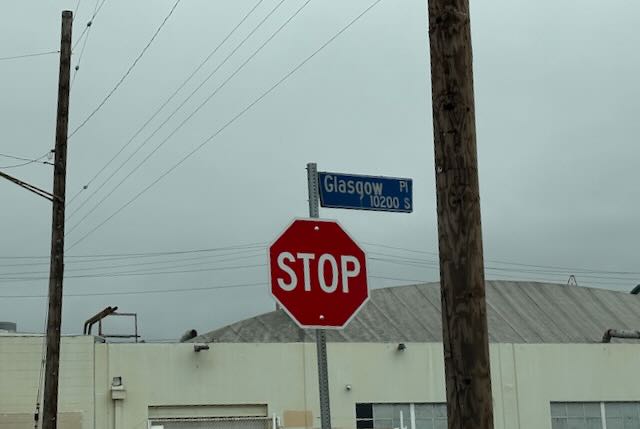
Unfortunately I instantly hit 25 miles of the famous LA traffic. Six lanes on either side of the highway and nose to nose with the other travellers for the best part of an hour and a half. Absolute pish.
I arrived with star of the show, Chris Meyer, already set up and starting to discuss his compositions and some notes on his setup. I’ve mentioned Chris’ Learning Modular site on multiple occasions on the Signal Sounds site and emails as being a worthwhile resource no matter what stage you’re at on your journey through wires and bleeps and although we’ve had email correspondence for years, I’d never actually met him in person.

Chris is a natural storyteller and over the next day or two he regaled me with tales from his days working at Sequential Circuits, Tom Oberheim's Marion Systems, Roland and over 20 years of Hollywood TV and film work. I had recently bought a Prophet VS so having a conversation about its design concepts, limitations and features with the guy who was a big part of the team who invented the instrument gave me a real buzz.
His performance was based around what you could loosely call a “hybrid” system - the sound sources were mainly from his reasonably compact Eurorack system, the mixing and effects and some manual triggering coming from a collection, Ableton Push and other digital instruments, footswitches and triggers. Really nice to see the merging of the two worlds and it worked without a glitch on the night.

He performed two compositions, both around 30 minutes. The first based around some field readings a friend of his from Ukraine had made of real world battle sounds in Kyiv and the second leaning into the Chris’ research of the Native American Indians of his new found home of New Mexico. It’s really easy to take source material like this and make a complete arse of it but I thought he did a great job of weaving both themes into each performance without it being schmaltzy, obvious or overbearing.
Lewis, whose studio we were in, has a 24-hour-a-day and completely genuine perma-grin on his face and a ton of history under his belt. He’s owned every synth that we currently lust after (MPC60, Yamaha CS-80, every Jupiter you can think of, all the Prophets…everything) but although he acknowledges it would be nice to have a few of them about now in order to pay off his mortgage, he had a refreshing “they’re all tools and when I’m not using them, I move them on to someone who will” approach (something I sadly lack myself).

After the performance Chris hung about for a while answering questions and chatting with the folks gathered there and then I bumped into Dave Small who runs Catalyst Module. A few years go Dave made a bit of a buzz in the community by releasing an entire series of Buchla 100 modules in Eurorack but the whole thing kind of collapsed in on itself as Buchla itself had recently come under new management and…after a brief rebrand as Red Panel the whole thing kind of fizzled out. Dave was very philosophical about the whole thing and felt he had learned a lot about module production and business in general and was ready to come out with a new range of valve-based modules later this year. Fun fact - Dave from Catalyst has literally never been seen in public without his black beanie hat. Ever. If I see him at Superbooth I'll take a photo as I forgot on this occasion. You'll just have to trust me.
NAMM Day 1 - actual NAMM
It’s straight into the main event with a wander up and down the many, many, many aisles and getting a feel for the new layout and where everyone is situated. There was quite a focus on some historical aspects of the business this year, there being a presentation set up to commemorate 40 years of MIDI and some of the people who were the driving force behind what helped to tie together the instruments from a gazillion different manufacturers and make them work (mostly) in harmony. The stand had banners celebrating both Dave Smith and Ikataro Kakehashi whose vision helped steer MIDI into creation, and also Roger Linn, Dave Rossum, Tom Oberheim and Korg’s Tsutomu Katoh.
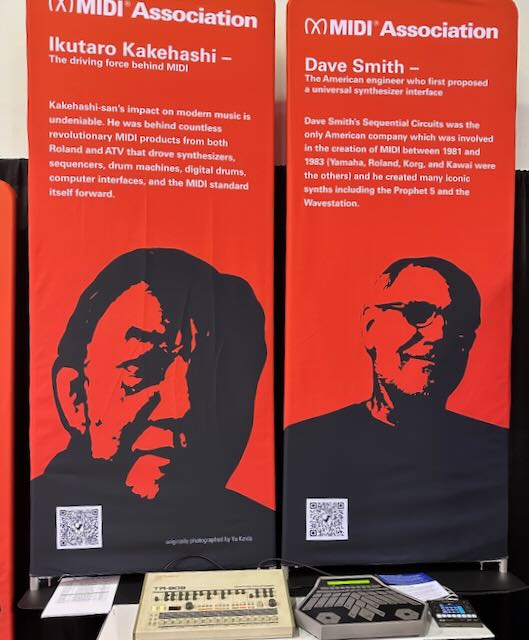
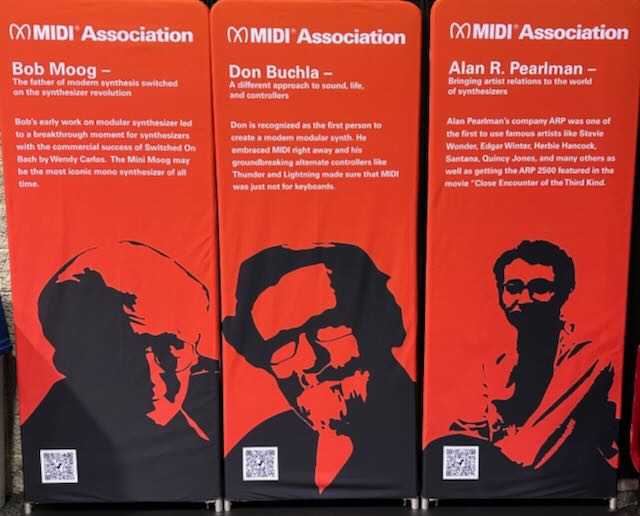

A nice selection of vintage gear was on display along with some updated classics (a MiniMoog with MIDI was a worthy addition as well as the recent E-mu SP-1200 reissue from Rossum-Electro) and some rarities including the Lightning controllers from Don Buchla. These were effectively motion-sensing “wands” connected to a half rack processing unit that converted the movement of the rods into MIDI controller information. There’s a lot of focus these days on non-conventional controllers (Genko and Instrument of Things now do similar work using Bluetooth) but Buchla was doing this in the mid-90s, over 25 years ago.
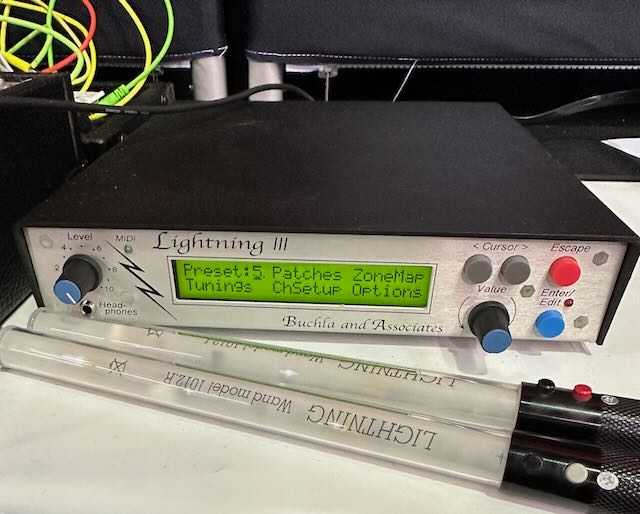
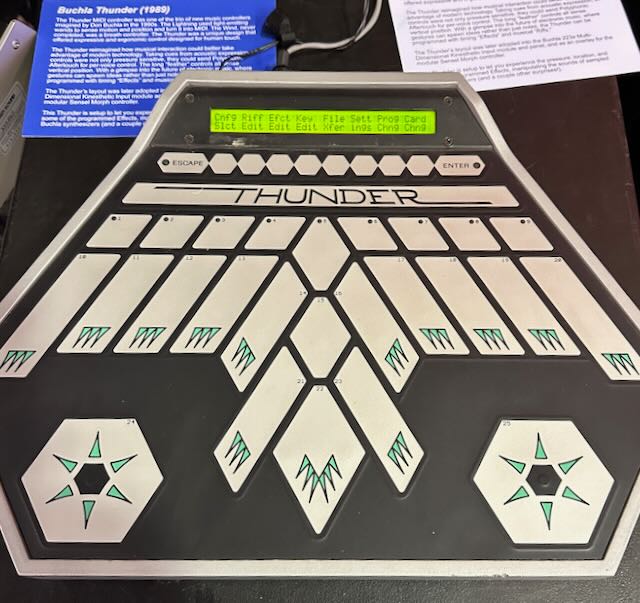
First up on the booths was my old mate Daniel Troberg who always has some warm words and spectacular moustache action at the ready. Daniel was one of the very first employees at Elektron (think he was Number 3 on the payroll) and after setting up their US and South America distribution network, moved over to be head of Global Sales for ASM who make the mighty Hydrasynth. Daniel has a deep knowledge of the business side of the music industry but he’s also a very talented Techno producer and here he is presenting me with his first vinyl release in years, the imaginatively named “LP”.
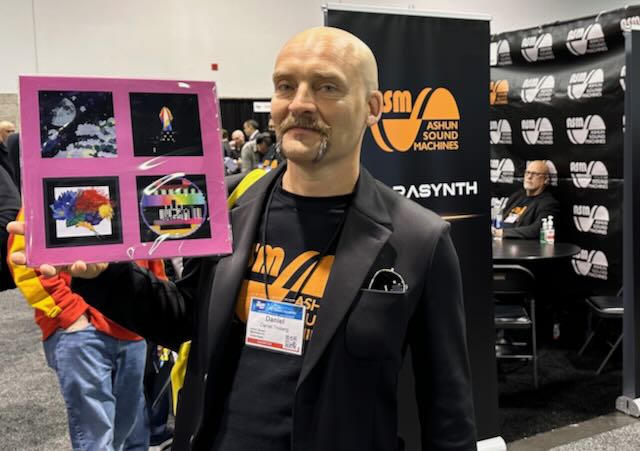
The chap looking suspiciously over his shoulder at me is actually Glen Darcy, the lead technical designer on the Hydrasynth and the guy behind a lot of Arturia’s instruments (MiniBrute, Beatstep Pro, Matrix Brute and many others).
Next up I hit the Polyend stand where our old friends Piotr and Cezary were showing off the new handheld sampling and sequencing powerhouse, Tracker Mini as well as their existing Play and Tracker desktop units and trying to pour oil on troubled waters over some internet beef caused by some indelicate Tweets by Benn Jordan the night before. Oops. At the end of the show the Tracker Mini was awarded “Best In Show” (as in the best new product at NAMM, not just in a particular category) so I’m pretty sure the journey was worth it for them.
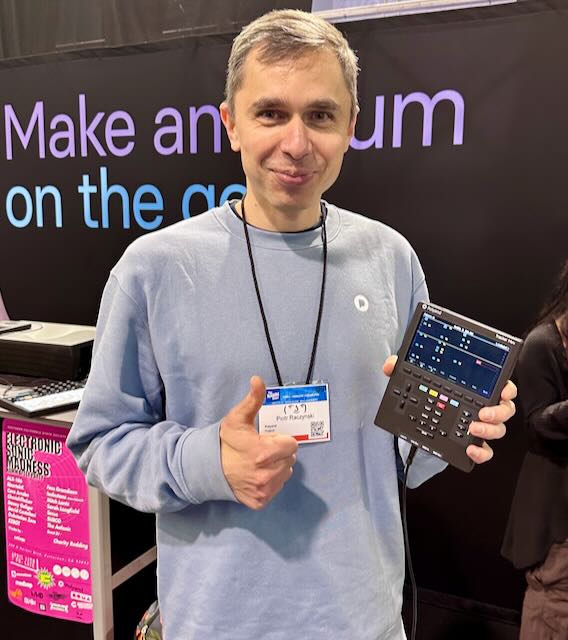
4ms, Endorphin.es and Verbos were all in attendance so I had a chance to look at their new gear. 4ms releasing some simplified Delay and Sampling modules:

Endorphin.es released standalone "guitar pedal" versions of their "end of chain" Master EQ module, Golden Master and a similar format "Ghost", the collaboration they recently did with Andrew Huang. it's an interesting side step in terms of their range although it harks back to the very earliest days of Eurorack when both 4ms and Malekko were producing Guitar Fx pedals before they started doing modular.
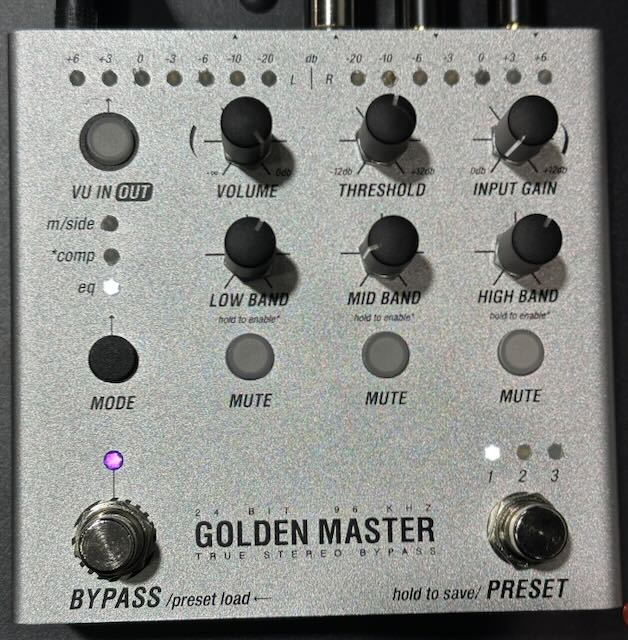
And last but not least, Verbos had a new module (which is fairly rare for them), the Real World Interface (Audio input and Envelope Follower with Gate/Trigger out)

After a hard day slogging around the show I went to meet Tada from Boutique Pedal NYC, a kindred spirit selling cool and weird instruments from his place in San Diego (definitely drop him a mail if you’re ever in that part of the world, he’s a great guy) and we headed to the South California Modular Society jam session.
This was in a dive bar in Fullerton, a few miles North of Anaheim (and I'll ALWAYS take a chance to get out of Anaheim when I can, it's a fairly soulless place based around hotels, fast food and Disneyland) featuring live performances from more than 20 artists. Things like this can go two ways - quite a lot of ambient bleeps and bloops and lots of gaps in between sets or…in this case, a very fluid night with a huge variety of styles and a ton of energy.
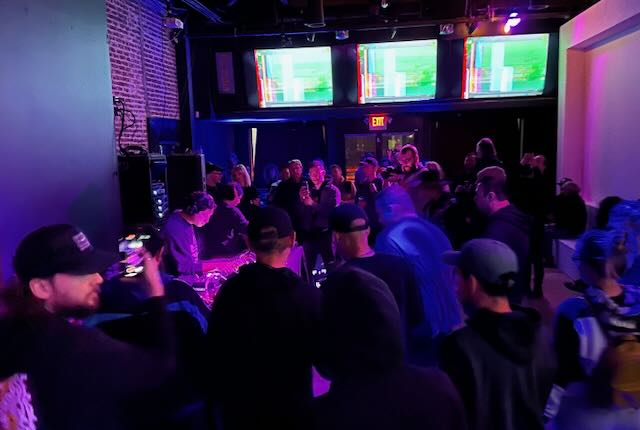
The night was definitely more “beat” lead than other events I’ve been too with some heavy rave-era brekbeat and stabbing chordsds morphing into deep house morphing into blistering break core and back round again several times. Alex from WMD was there as were several other movers and shakers from the modular scene but I spent most of the evening shooting the breeze with Aaron from 1010 Music (the tallest man in Modular by a country mile) and Chris Meyer and a few of the local folks that Tada introduced me too.
I got the distinct impression that there’s a larger market for live modular performance in the US, especially in the club/dance music scene, really showing me how the modular scene continues to grow an break through into new areas. Being from Glasgow I found it difficult to say "No, I'm fine" when several people offered to buy me a drink all in the space of half an hour so the rest of the night and journey home will remain a fuzzy memory.....

